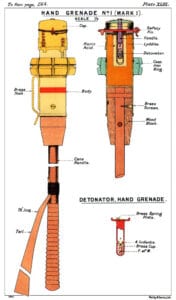A 5 inch by 3 inch diameter on a 5 inch wooden cane.
The hand grenade No.1 was the first British hand grenade used in World War I. It was designed in the Royal Laboratory, based on reports and samples of Japanese hand grenades during the Russo-Japanese War provided by General Sir Aylmer Haldane, who was a British observer of that war.
When the battlefield became confined to the trenches, the long handle became a liability, causing several accidents. Reaching back for the throw, the fuse could strike the trench side. The No. 3, a variant of the No. 1, had a shorter handle for easier use in trenches.
Even with these adjustments, the No. 1 and its variants did poorly in battle. According to German prisoners captured at Ypres in January 1916, the No. 1 could be deflected by wooden boards. In some cases, the deflected grenade could be thrown back.
Manufacturing the No. 1 was difficult, as it required a special detonator that could only be produced by the ordnance factories. Because of this, the British Expeditionary Force got far fewer No. 1s than were ordered. A version that used a more common detonator, the No. 18, was designed, but by then battlefield experience had shown that the No. 1’s design was ineffective.


